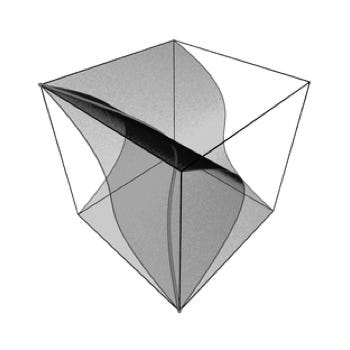
It’s fair to say that John F. Nash Jr. (1928-2015) didn’t earn much respect from pure mathematicians for his work in game theory. To them, his use of L.E.J. Brouwer (1881-1966) and Shizuo Kakutani (1911-2004)’s fixed-point theorems to show the existence of Nash equilibria in finite games with mixed strategies was and perhaps still is merely considered “not surprising applications of well-known methods” (Milnor, 1998). Indeed, even John von Neumann (1903-1957)—when confronted with Nash’s result—is to have replied “That’s trivial, you know. That’s just a fixed point theorem”.
Although—by far—recognized most widely for the work he did in game theory, Nash in the 1950s however also wrote groundbreaking papers on real algebraic geometry, topology and partial differential equations. Indeed, he won the Abel Prize in 2015 for his work on the latter, alongside Louis Nirenberg (1926-2020), considered one of the most outstanding pure mathematicians of the 20th century. For pure mathematicians, this subsequent work of Nash’s, which was accomplished just before his illness set in, is considered far more rich and important.
A bibliography assembled by his friend John Milnor (1931-) in 1998 lists 21 publications to Nash’s name. However, excluding his work in game theory and economics, as well as conference papers and book chapters, Nash’s original work in pure mathematics is essentially contained in four journal papers, written between 1952-58:
Nash, J.F. 1952. Real Algebraic Manifolds. Annals of Mathematics 56(3), pp. 405-421.
Nash, J.F. 1954. C¹ Isometric Imbeddings. Annals of Mathematics 60(3), pp. 386-396.
Nash, J.F. 1956. The Imbedding Problem for Riemannian Manifolds. Annals of Mathematics 61(3), pp. 20-63.
Nash, J.F. 1958. Continuity of Solutions of Parabolic and Elliptic Equations. American Journal of Mathematics 80(4). pp. 931–954.
This week’s newsletter superficially discusses the content of these papers for the casual reader. Some knowledge of mathematics is recommended.
Nash’s Research (1948–58)
In the taxonomy of mathematicians, there are problem solvers and theoreticians, and, by temperament, Nash belonged to the first group. — Nasar (1998)
As a consequence of the mental illness that would later consume him, Nash’s prime research career was remarkably short, essentially only spanning nine years from his arrival at Princeton in 1948 to his diagnosis in 1958. Raoul Bott (1923-2005) at Carnegie said this about Nash’s interests as a graduate student:
“Nash liked very general problems. He wasn’t all that good at solving cute little puzzles. He was a much more dreamy person. He’d think a long time. Sometimes you could see him thinking. Others would be sitting there with their nose in a book.”
Of his own graduate research, Nash himself stated in his Nobel autobiography that
“As a graduate student I studied mathematics fairly broadly and was fortunate enough, besides developing the idea which led to “Non-Cooperative Games”, also to make a nice discovery relating to manifolds and real algebraic varieties. So I was prepared actually for the possibility that the game theory work would not be regarded as acceptable as a thesis in the mathematics department and then that I could realize the objective of a Ph.D. thesis with the other results.”.
Of course, Nash ultimately didn’t need to “realize the objective of a Ph.D. thesis with other results”. He earned his Ph.D. in mathematics from Princeton in 1950 at the age of 22. His 28-page dissertation was entitled Non-Cooperative Games (1950). It is available here. Written under the supervision of topologist Albert W. Tucker (1905-1995), the main result of the paper is the derivation, definition and description of the properties of the Nash equilibrium. For those interested, Nash’s work in game theory was beautifully collected and organized in this article prepared for the Nobel Committee by his friend Harold W. Kuhn (1925-2014) in 1994.
Real Algebraic Manifolds (1952)
Nash’s “other potential Ph.D. thesis result” that he described as “a nice discovery relating to manifolds and real algebraic varieties” was very different from his work on the Nash equilibrium. Unlike his thesis, this very deep work was highly abstract and devoid of application, taking notice of as of yet undiscovered fundamental properties of geometric and algebraic functions and mappings.
In his paper Real Algebraic Manifolds (1952) Nash himself writes that the main purpose of the paper was to “develop some connections between differential geometry and real algebraic geometry”. Essentially he showed that any compact smooth manifold is diffeomorphic to some semialgebraic analytic submanifolds of some Rⁿ.
Definition of an algebraic variety A real algebraic variety, in the classical sense, is a set of solutions to a system of polynomial equations over the real numbers
Algebraic varieties are the central objects of study in algebraic geometry. They are objects defined by a locus of points described by one or more algebraic equations. One way of thinking about them is as a generalization to n dimensions of algebraic curves (set of points on the Euclidean plane whose coordinates are zeroes of some function of two variables) such as e.g. the unit circle, which is the set of zeros of the polynomial x² + y² — 1. The twisted cubic is an example of an algebraic variety, being a smooth, rational curve C of degree three in projective 3-space P³.
Definition of a manifold A manifold is a topological space that locally resembles Euclidean space near each point, i.e. each point of an n-dimensional manifold has a neighborhood that is homeomorphic to the Euclidean space of dimension n.
Manifolds, on the other hand, are topological objects which locally resemble regular, normal Euclidean space i.e. “seem straight” in the case of a line in one dimension and “flat” in the case of a plane in two dimensions. Said simply, they are objects which globally are in fact topologically irregular, but locally seem not to be. You can read more about manifolds and topology in the previous newsletter The Poincaré Conjecture (1904):
The concept of a manifold is now central to many parts of geometry because it allows complicated structures to be described and understood in terms of the simpler local topological properties of normal Euclidean space. This makes them especially useful in physics, and in particular, cosmology and astrophysics. In one dimension, a manifold may be a straight line or a circle, but not a figure eight because it has crossing points that are not locally homeomorphic to Euclidean 1-space. In two dimensions, manifolds are surfaces such as planes, spheres, tori, klein bottles and the real projective plane, all of which can be embedded in three dimensional real space.
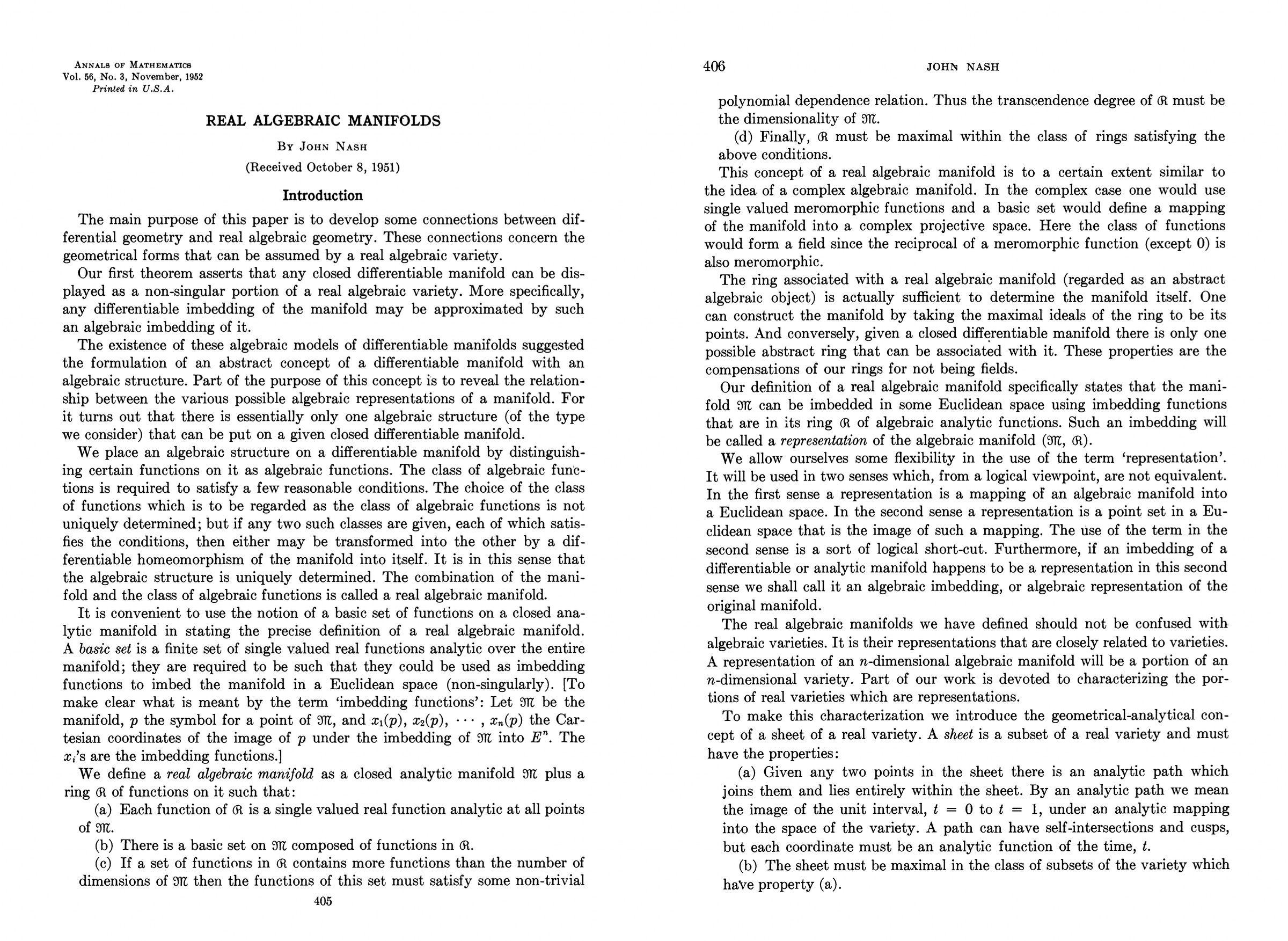
Algebraic manifolds, are algebraic varieties which are also manifolds. That is, they are a set of solutions to a system of polynomial equations which also locally resemble Euclidean space near each point. They can be defined both for real and complex numbers. As such, algebraic manifolds are a generalization of the concept of smooth curves and surfaces defined by polynomials. The most trivial example is the sphere, which can be defined as the zero set of the polynomial x²+y²+z²-1=0.
Nash’s paper looks especially at algebraic manifolds over R, i.e. those manifolds consisting of points defined by real numbers. Such functions have since come to also be known as Nash functions:
Definition of a Nash function A Nash function on an open semialgebraic subset U ⊂ Rⁿ is an algebraic function f: U → R satisfying a nontrivial polynomial equation P(x, f(x)) = 0 for all x in U
Some examples of Nash functions are:
Polynomial and regular rational functions; and
x → √(1+x²), which is Nash on R.
According to his unofficial biographer Nasar, Nash’s 1952 paper on algebraic manifolds was the only paper he was every truly satisfied with (Nasar, 1998 p. 266).
Manifold Embedding (1954-56)
Nash’s work in topology is by many considered his most brilliant. As Nasar writes, his brash style had established a high bar for Nash to live up to among his peers at Princeton:
“And, during a discussion in the common room, after one of Nash’s diatribes about hacks and drones, Ambrose said disgustedly, ‘If you’re so good, why don’t you solve the embedding problem for manifolds’ — a notoriously difficult problem that had been around since it was proposed by Riemann.”
So Nash did.
To what extent are the abstract Riemannian manifolds a more general family than the sub-manifolds of Euclidean spaces?
The question above, through various permutations, had been considered by mathematicians since the mid-1800s. In 1873, Ludwig Schlaefli (1814-95) discussed the local form of the problem by conjecturing that a neighbourhood in an n-manifold would generally require an imbedding space of (n/2)(n + 1) dimensions. Later, the problem was considered by the likes of Hilbert, Tompkins, Chern, Kuiper, Janet and Cartan (Kuhn et al, 2002). Nash’s own characterization of the problem in his Nobel autobiography subtly hints at his reasoning for devoting attention to the problem: “[The] problem, although classical, was not much talked about as an outstanding problem. It was not like, for example, the four-color conjecture.” (it is said that Nash would discount problems which he didn’t consider worthwhile of his time).
Nash eventually solved the problem in a highly technical paper entitled C¹-isometric imbeddings (1954). The paper is arranged in four parts. As Nash himself writes in Kuhn et al (2002): “At the end of part C the treatment of compact manifolds is complete and we state Theorem 2, which is essentially this:”
Every compact Riemannian n-manifold is realizable as a sub-manifold of Euclidean (n/2)(3n + 11)-space.
Nash’s theorem, later to become known as the Nash embedding theorem, states that any kind of manifold (surface, body, etc) which exhibits a certain level of smoothness (i.e. is void of intersections and singularities) can be embedded in Euclidean space. As Nasar writes, Nash showed that you can “fold the manifold like a silk handkerchief, without distorting it”.
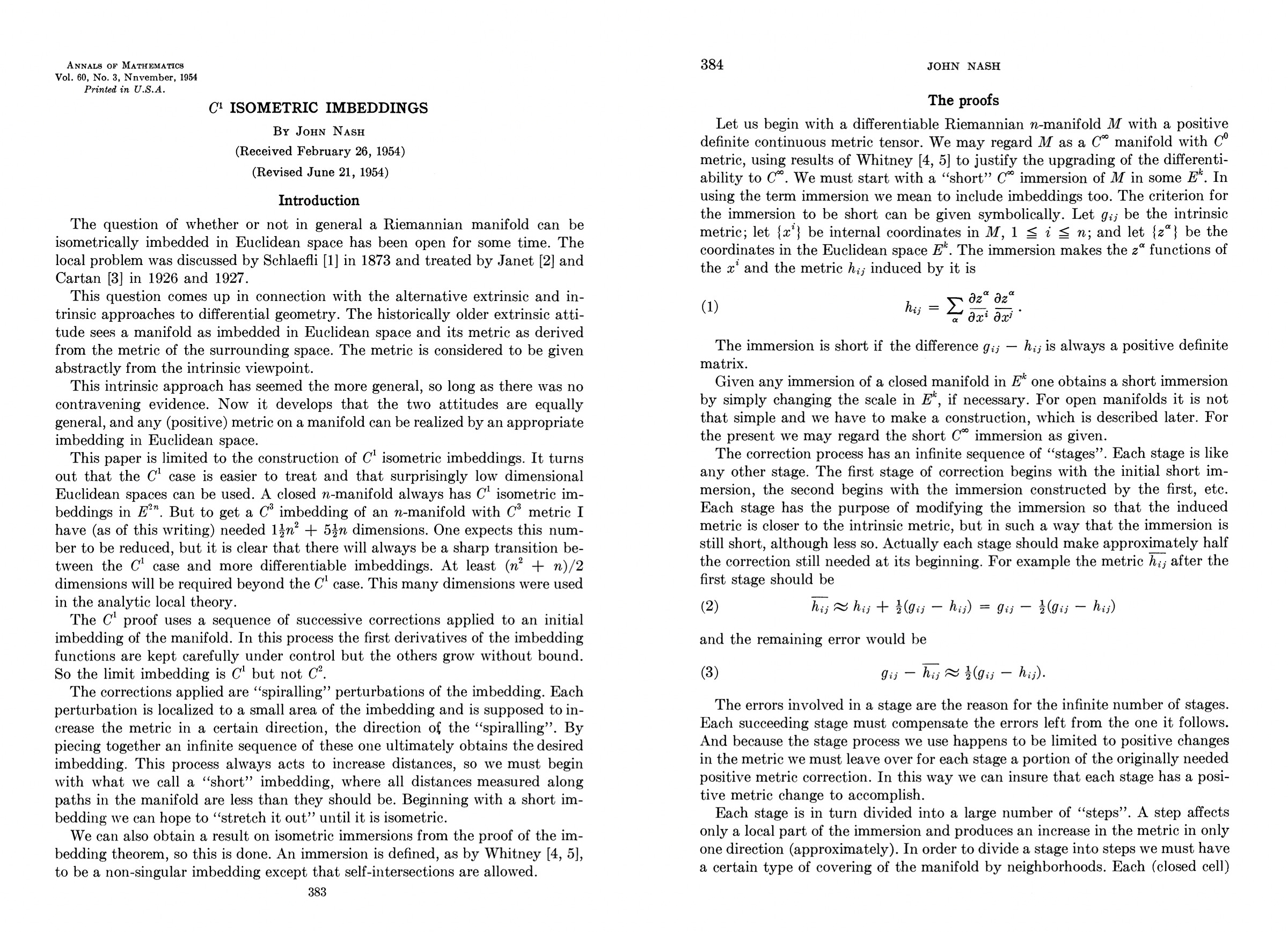
Nash’s proof answers the question of whether it is possible “to embed any Riemannian manifold in a Euclidean space”. On the one hand, this “deeply philosophical question” concerning the foundations of geometry had likely been one which every mathematician interested had asked himself (Nasar, 1998 p. 326). On the other hand, Nash’s proof provided an important and definitive answer to an open problem which most people, indeed even most experts in the field, would have thought to be false. Unlike his work in game theory, the result established Nash as a first rate pure mathematician. As Mikhail Leonidovich Gromov (1943-) would later state:
“Nash was solving classical mathematical problems, difficult problems, something that nobody else was able to do, not even to imagine how to do it. […] But what Nash discovered in the course of his constructions of isometric embeddings is far from ‘classical’ — it is something that brings about a dramatic alteration of our understanding of the basic logic of analysis and differential geometry. Judging from the classical perspective, what Nash has achieved in his papers is as impossible as the story of his life […] [H]is work on isometric immersions […] opened a new world of mathematics that stretches in front of our eyes in yet unknown directions and still waits to be explored”
Two years after the publication of Nash’s paper in the Annals of Mathematics, he published a second paper on the same topic entitled The Imbedding Problem for Riemannian Manifolds (1956). Submitted about six months after the first, this paper tackled the more general case of Cᵏ imbeddings.
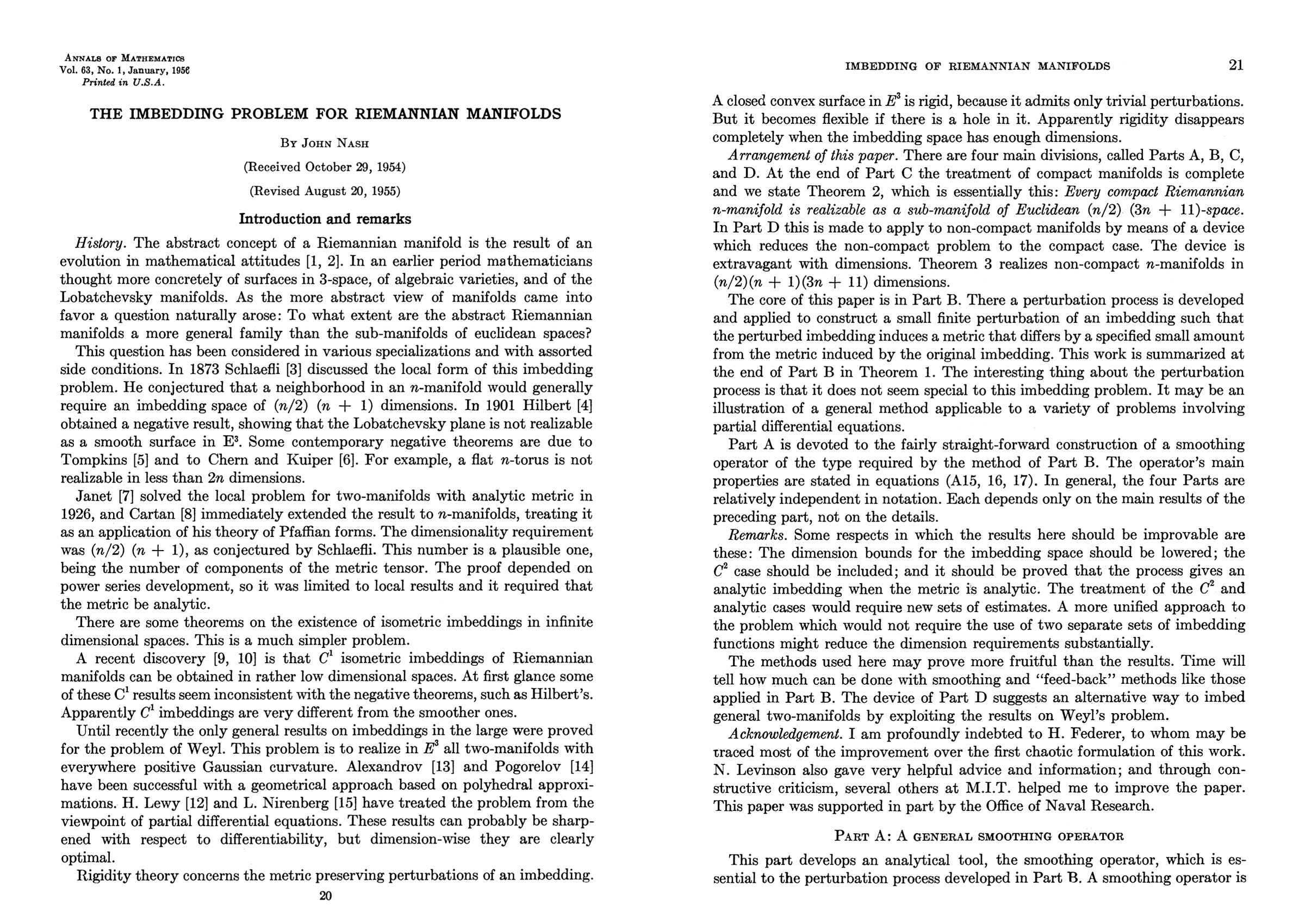
Partial Differential Equations (1958)
The paper that would eventually lead to Nash being awarded the prestigious Abel Prize alongside Louis Nirenberg in 2015 is entitled Continuity of Solutions of Parabolic and Elliptic Equations (1958). The paper tackles nonlinear partial differential equations. Regarding its origins, Nirenberg recalled to Nasar (1998):
“I worked in partial differential equations. I also worked in geometry. The problem had to do with certain kinds of inequalities called elliptic partial differential equations. The problem had been around in the field for some time and a number of people had worked on it. Someone had obtained such estimates much earlier, in the 1930s in two dimensions. But the problem was open for [almost] thirty years in higher dimensions."
Supposedly, Nash started working on the problem as soon as it was suggested by Nirenberg, although first ensuring himself of the importance of the problem by checking with colleagues. “For Nash, it had to be important in the opinion of others” (Nasar, 1998). The problem fit Nash’s criteria.
Mathematicians in the 1950s had known about relatively trivial routines for solving ordinary differential equations (ODEs) using computers. There were however, no established methods for solving nonlinear partial differential equations, such as those that occur during the turbulent motions of a jet engine. Nash himself wrote about the work:
“Little is known about the existence, uniqueness and smoothness of solutions of the general equations of flow for a viscous, compressible, and heat conducting fluid. These are a non-linear parabolic system of equations. An interest in these questions led us to undertake this work. It became clear that nothing could be done about the continuum description of general fluid flow without the ability to handle non-linear parabolic equations and that this in turn required an a priori estimate of continuity.”
- Excerpt, A Beautiful Mind* by Sylvia Nasar (1998)
According to Nasar, it took Nash about six months to arrive at his theorem, which was achieved through a process of Nash visiting Nirenberg’s office weekly to discuss his progress. “It was weeks before Nirenberg got any real sense that Nash was getting anywhere” (Nasar, 1998). By the spring of 1958 however, Nash was able to obtain basic existence, uniqueness and continuity theorems using methods of his own invention. Astoundingly, the methods involved “transforming nonlinear equations into linear equations, and then attacking these by nonlinear means” — something nobody had thought of before, “a stroke of genius” according to Peter Lax (1926-), who followed his progress closely. Regarding the technique, Lars Gårding (1919-2014), a Professor of Mathematics at the University of Lund and specialist in partial differential equations later declared, simply, “You have to be a genius to do that”.
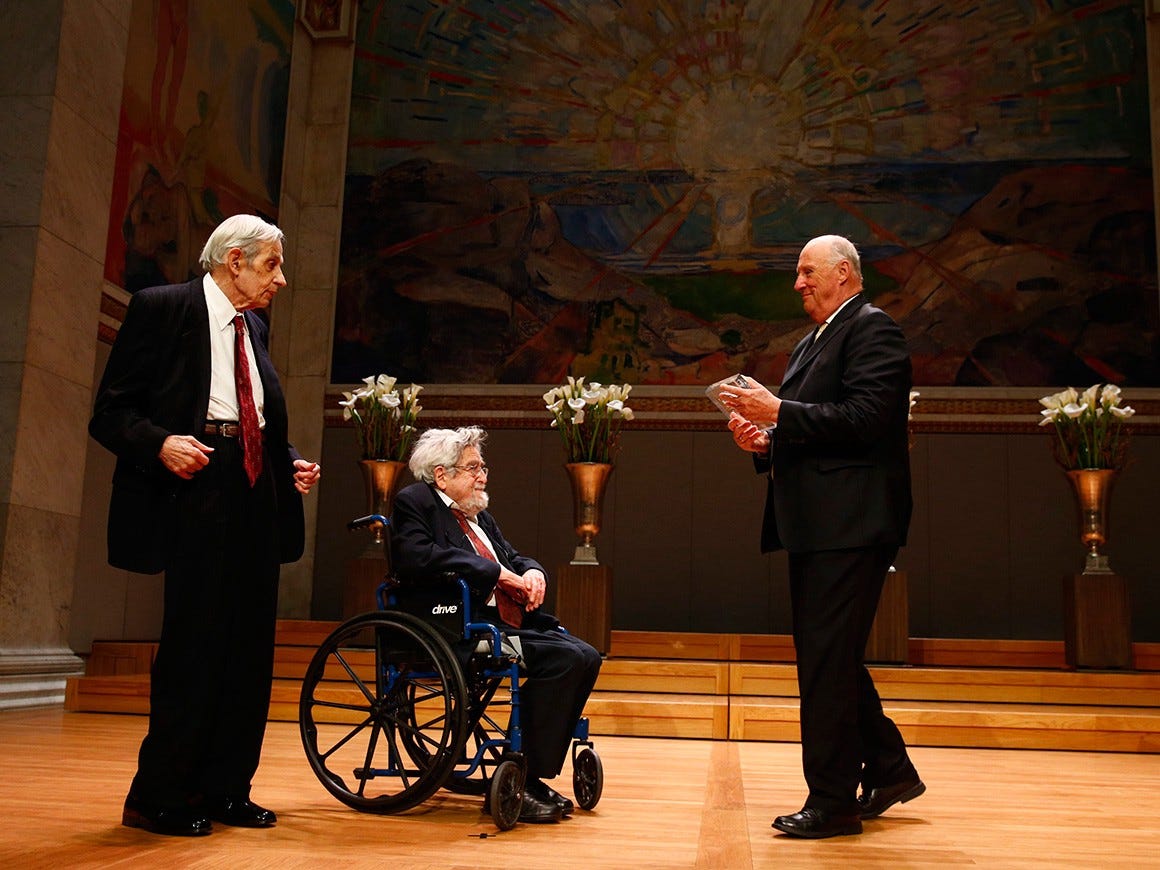
Around the same time as Nash was working on manifold imbedding—as the story goes—he was also trying to prove Hilbert’s nineteenth problem (a problem involving elliptical partial differential equation). He eventually did solve it in 1956, however learning that Italian mathematician Ennio de Giorgi (1928-96) had published a proof of the same result months before Nash achieved his. Although the methods used in their solutions were different, it has been speculated that if only one of them had solved the problem that year, that person would have been in contention for the prestigious 1958 Fields Medal.
Despite not winning a Fields that year, around the same time Nash’s accomplishments did catch the attention of the popular press as Fortune Magazine featured a story on the 30 year old in their July 1958 issue. Still ten years until his 40th birthday (the Fields Medal is awarded only to mathematicians under the age of 40), Nash was diagnosed with schizophrenia that same year and never again published any other original work in pure mathematics as a consequence.
The Fortune story was later republished on the magazine’s website following Nash’s death in 2015.
See Nash’s full bibliography in John Milnor (1931)’s 1998 biography of Nash entitled
Milnor, J. 1998. "John Nash and ‘A Beautiful Mind’". Notices of the American Mathematical Society 25 (10), pp. 1329–1332.
Those interested in reading more about Nash’s work in pure mathematics are encouraged to pick up the book The Essential John Nash*, edited by his friend Kuhn and biographer Nasar.
I hope you enjoyed this week’s newsletter. Please consider sharing it with a friend who might be interested.
Thank you, as always, for being a subscriber.
Sincerely,
Jørgen
Related Privatdozent Essays
Nash's Bargaining Problem (1950), December 3rd 2021
John F. Nash Jr.’s Game of “Hex”, October 10th 2021
The Poincaré Conjecture, August 1st 2021
The Anarchist Abstractionist — Who was Alexander Grothendieck?, September 17th 2021
The Mathematics of Ted Kaczynski, April 18th 2021
About
The Privatdozent newsletter currently goes out to 8,341 subscribers via Substack.
References
Kuhn, H.W. & Nasar, S. 2002. The Essential John Nash*. Princeton University Press.
Milnor, J. 1998. "John Nash and ‘A Beautiful Mind’". Notices of the American Mathematical Society 25 (10), pp. 1329–1332.
Nasar, S. 1998. A Beautiful Mind*. Simon & Schuster.
Nash, J.F. 1952. Real Algebraic Manifolds. Annals of Mathematics 56(3), pp. 405-421.
Nash, J.F. 1954. C¹ Isometric Imbeddings. Annals of Mathematics 60(3), pp. 386-396.
Nash, J.F. 1956. The Imbedding Problem for Riemannian Manifolds. Annals of Mathematics 61(3), pp. 20-63.
Nash, J.F. 1958. Continuity of Solutions of Parabolic and Elliptic Equations. American Journal of Mathematics 80(4). pp. 931–954.



